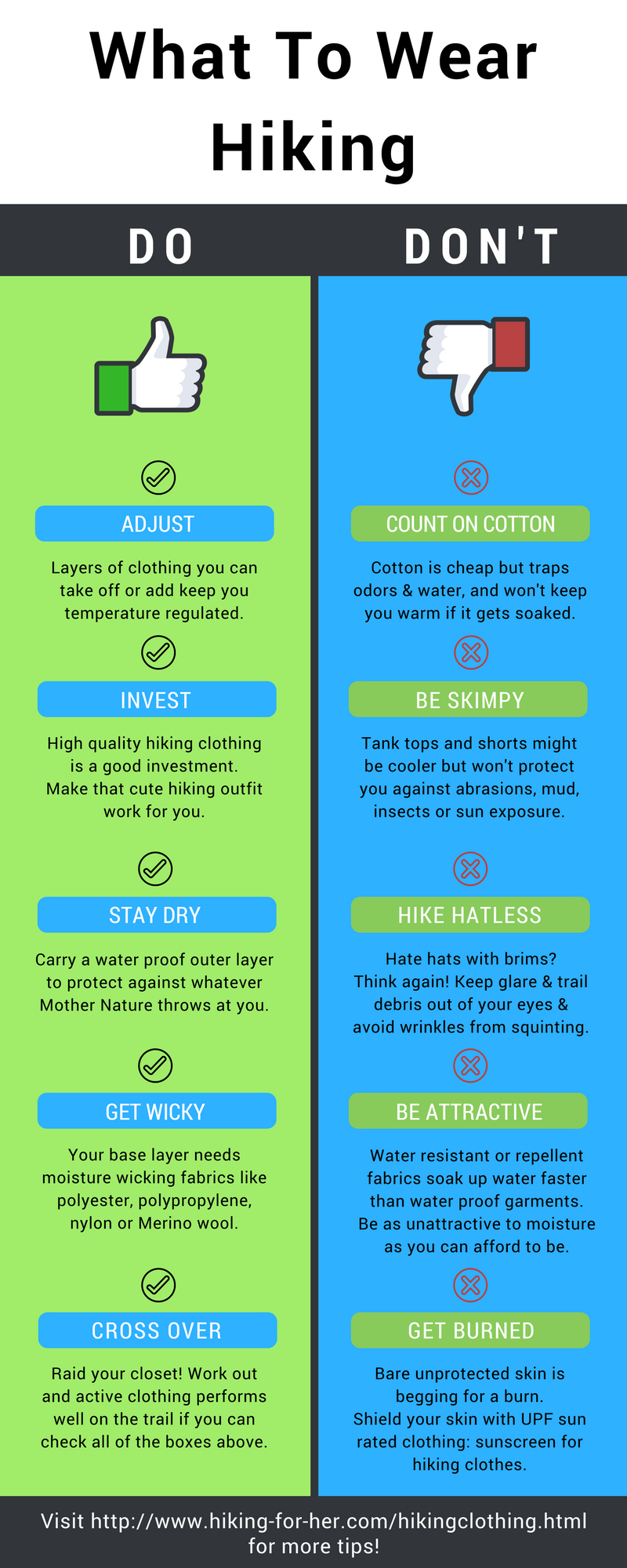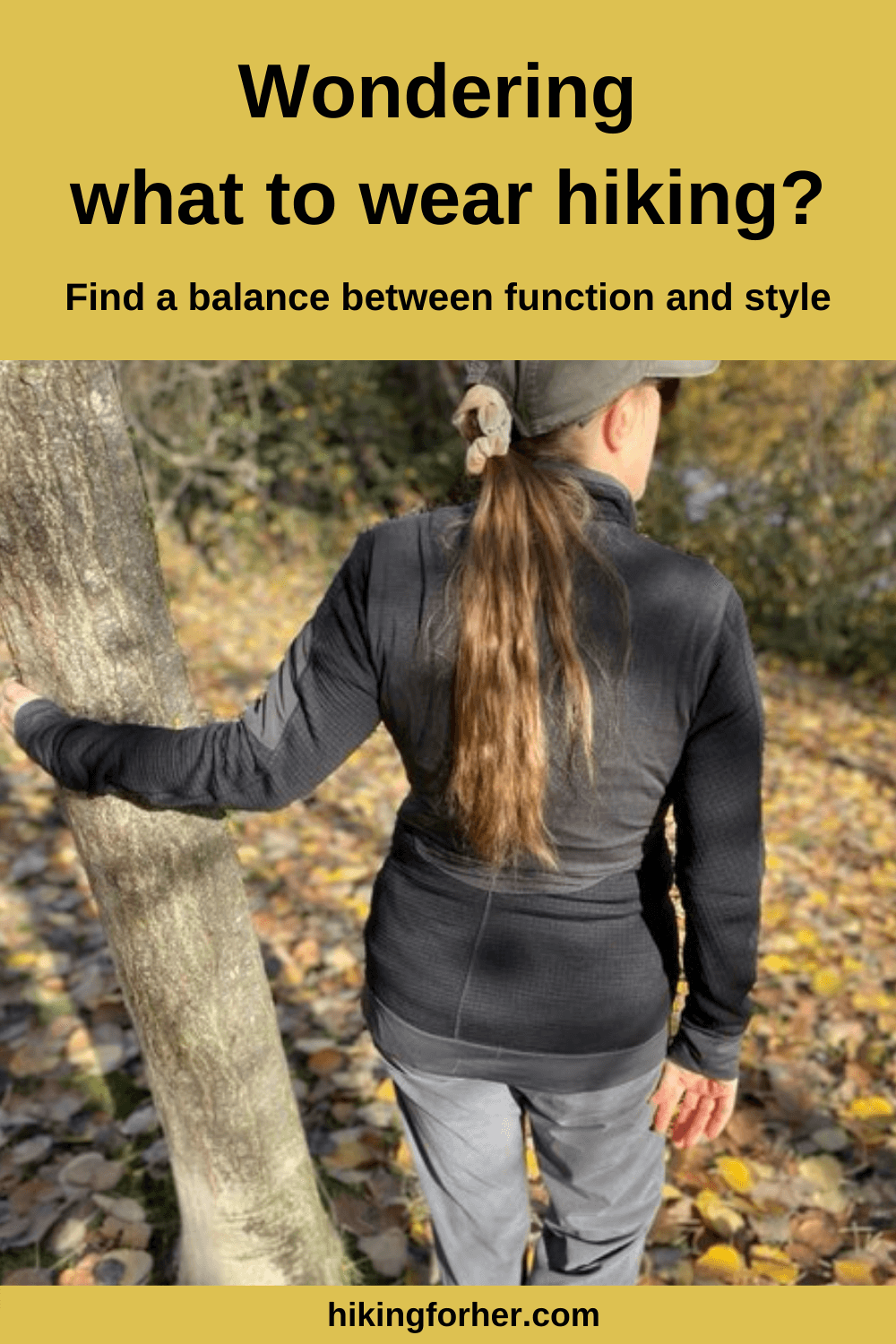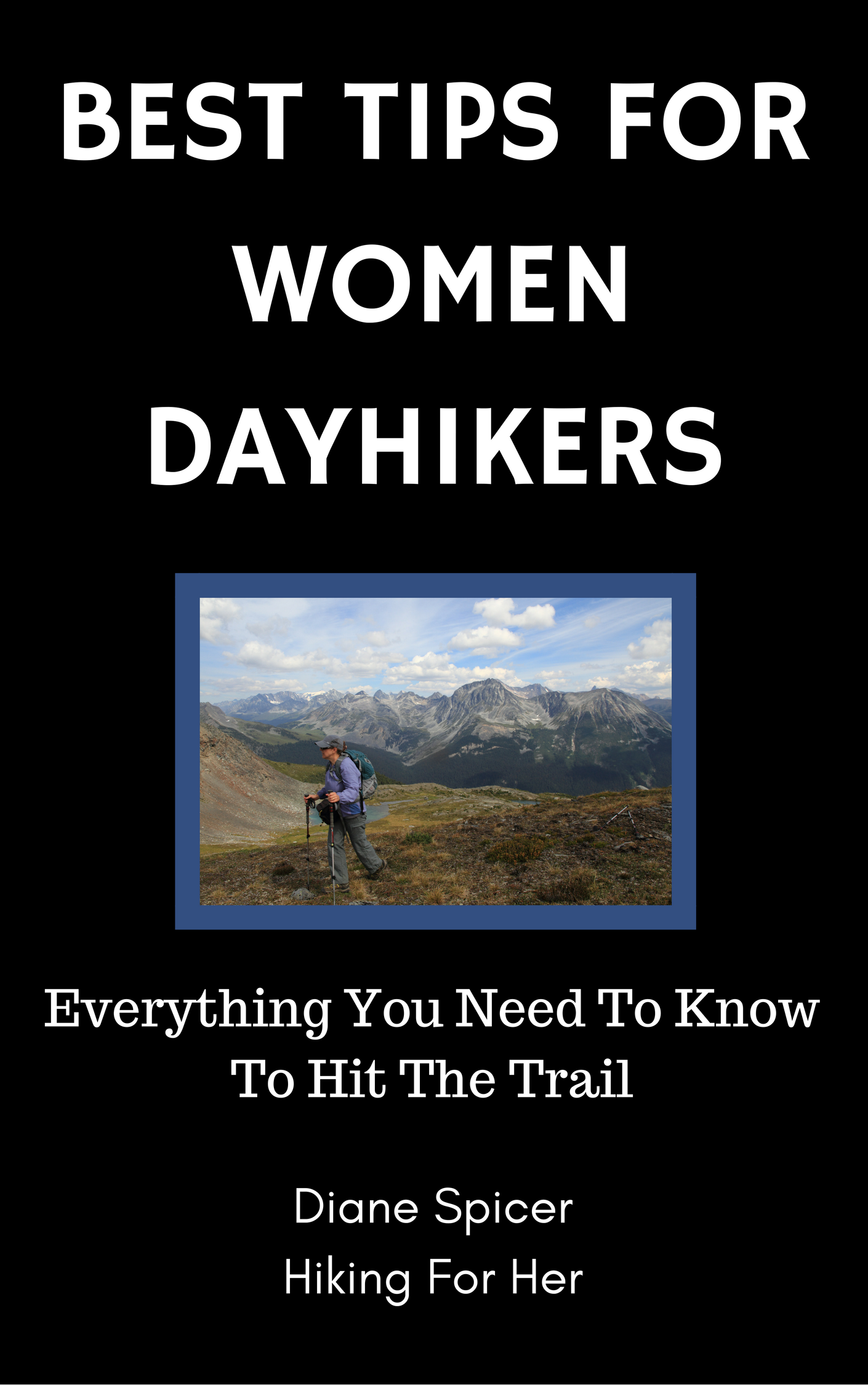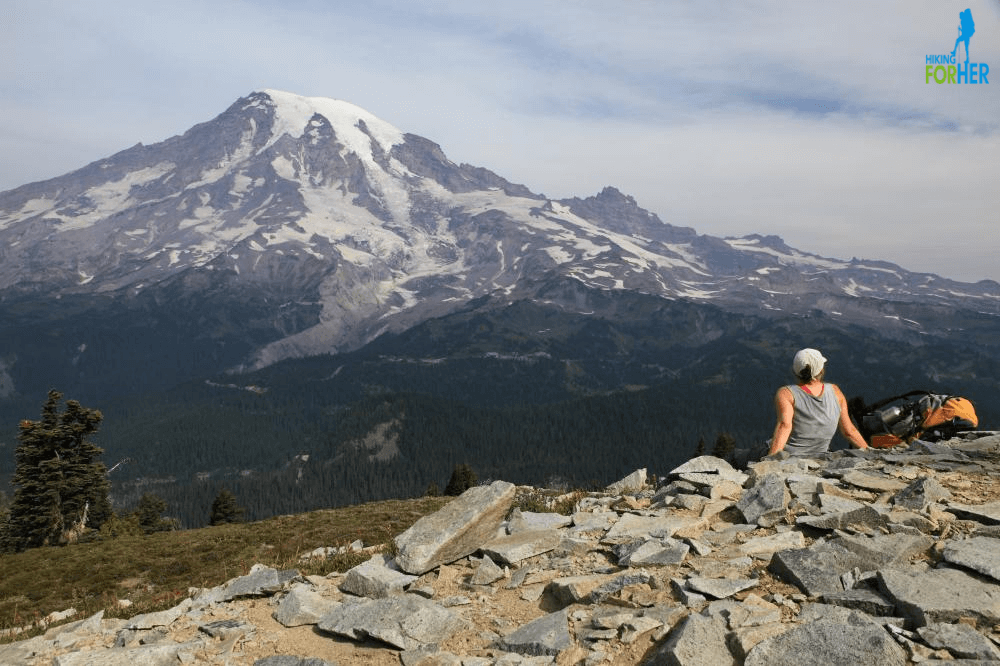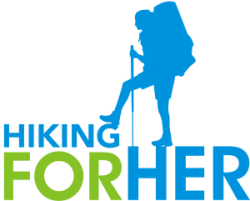
What To Wear Hiking Guide For Female Hikers
By Diane Spicer
Looking for ways to solve that vexing dilemma of what to wear hiking, especially as a beginner hiker?
You are in the right place.
I've got decades of hiking experience under the hipbelt of my backpack, and I'm eager to share my recommendations for what you need to wear hiking.
Cut to the chase with this handy Hiking For Her What To Wear Hiking infographic, or keep reading!
What women are looking for in hiking clothing
- You want durable, protective hiking clothing that stands up to the mud, dust, rocks, roots and brush on the trail.
- You need fabric that is moisture wicking, lightweight and quick drying. Synthetics such as a nylon blend or Merino wool, rather than cotton, is the hiking rule.
- You want to stay warm but not too warm, dry under all conditions, and as comfortable on the way back to the trail head as you felt during the first few minutes on the trail.
- And you want to dress for a hike without sacrificing style: you want to look good in your hiking attire!
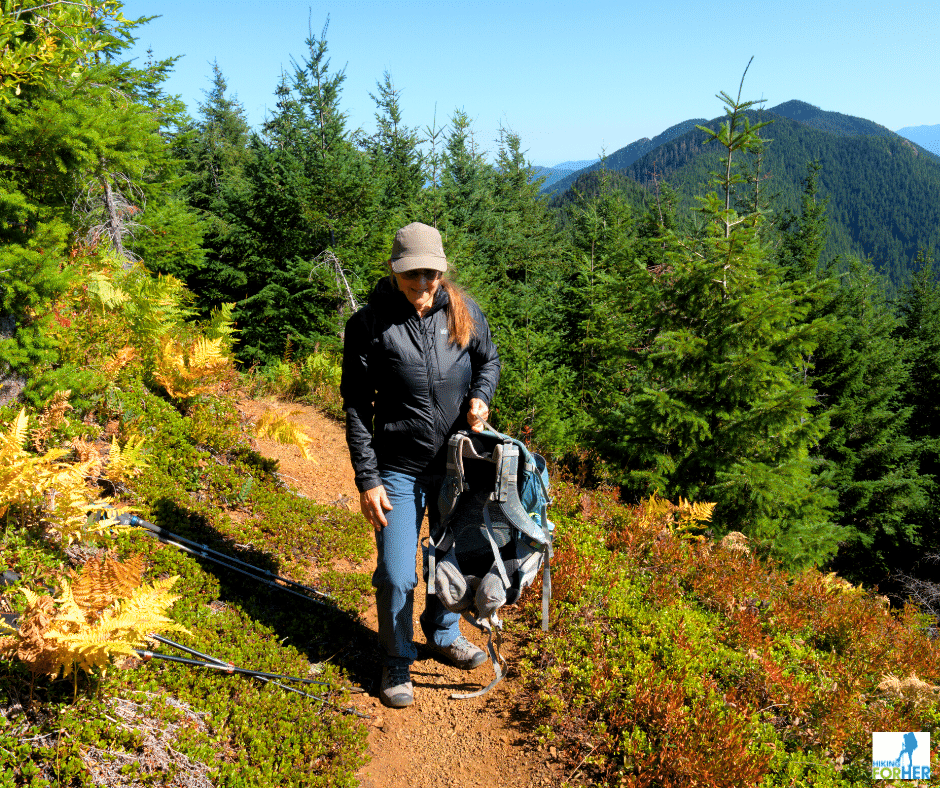
I'm happy to share with you what I recommend to the women hikers who ask me what to wear hiking, right here on this page.
All of this clothing is something I myself have purchased and worn on daily training walks, hiking trips, day hikes and backpacking adventures over the decades of trail time I've enjoyed.
I know it works, and I trust these brands and outdoor companies.
Because I trust their products after decades of using them as a member, Hiking For Her is an affiliate of REI Co-op. That means you pay nothing extra when you use my links, but you help support HFH.
Have you noticed the absence of ads on this website? That's on purpose, to give you the best possible page experience.
Quick tips about how to choose hiking clothes
Most hikers sort themselves into three categories:
- Beginner hiker: You have never been hiking, or on a few short day hikes.
- Intermediate hiker: You've enjoyed several seasons of hiking in moderate conditions and various lengths of hiking trips.
- Hardcore hiker: You hike every week, year round, rain or shine in all kinds of terrain and make backpacking a regular occurrence.
My best advice for beginner hikers
As a beginner, start off with just a few basic pieces of hiking-specific clothing.
Rummage through your closet and see if you can come up with a hiking outfit that you can wear on your first few hikes in mild conditions.
After you figure out what you'd like to upgrade, only then go shopping for hiking clothes.
In fact, prioritize your purchases to just 3 things: hiking socks, sturdy and protective trail footwear, and a good hiking jacket.
Hiking clothing has many different price points (and quality)
Here is an important thing to note when you go shopping for what to wear hiking: Beginner, intermediate and expert hiker clothing will have different price points, linked to the quality, durability and functionality of materials.
No surprise, right?
So what type of hiking clothing are you looking for today?
- The bare minimum to get me onto the trail as a beginner hiker or a woman on a budget
- A functional, durable and versatile wardrobe of hiking clothing built over time with thoughtful decisions
- Performance pieces of athletic clothing that will pay back a money investment with high function on every tough hike
The price points will vary accordingly.
Dress in hiking layers for inner to outer protection and comfort
One of the sacred tenets of hiking is that regardless of which type of hiking clothing you wear, you should dress in layers, and for so many good reasons.
You can get up to speed with the idea of a hiking clothing layering system, and I'll wait right here.
Each season brings new challenges to staying comfortable on a hike, so check out these what to wear hiking tips, too:
- spring hiking clothing
- fall hiking clothing
- extended sizes fall hiking clothes
- winter hiking
- extended sizes warm weather hiking clothing
Now let's use the concept of a hiking layering system to answer your question about what to wear hiking.
We'll start with base layers, which are worn against your skin, and work our way outward until you know exactly what you need to wear for comfort and safety on a hike.
Women's hiking underwear
As a hiker, you want a sports bra and panties that don't cling or stay soaking wet against your skin.
If you're backpacking, you want fast drying fabrics that can be easily washed out in the evening and be dry by morning.
The choices may seem endless and confusing, so here's what I wear and trust as all important base layers:
Women's hiking shirts and tops
Along with your hiking sports bra and underwear, your choice of shirts and tops are considered a base layer for your upper body because you can add and subtract an extra shirt and jacket over them.
If you're hiking in warm weather, you want good ventilation and moisture wicking fabrics that dry quickly without being stinky.
In winter, you want your hiking shirt to trap heat generated as you hike without becoming soaked.
So it might seem that your choice of fabrics would be different. But here's something I've learned over the years: Merino wool is a great choice for a hiking shirt year round.
What differs by season is the sleeve length and thickness of the shirt.
In summer, as a base layer wear this REI Co-op Merino wool short sleeve shirt.
In winter, choose this REI long sleeve base layer hiking shirt, available in two thicknesses and either pull over or half zip styles.
For non-Merino options, I wear this REI Sahara scoop neck short sleeve shirt, because I like the freedom to add a wicking neck gaiter (fitted scarf) to protect against UV exposure and insects on sunny trails. It's made of recycled polyester (as is the gaiter) so it will soak up sweat and dry fast.
To layer over it, this REI button-front long sleeve shirt is perfect because the sleeves are adjustable lengths and the back panel provides ventilation (a feature found on shirts at a much higher price point). I tie mine to the outside of my backpack to keep it handy when it turns cloudy or buggy.
Here are lots more of my tips on choosing the best hiking shirts.
Hiking jackets for women
To finish up our top layer, we need an outer layer, a jacket that protects against UV rays, wind, moisture and cold temperatures.
That's a jacket designed for women hikers.
But not all hiking jackets are created alike.
You want a jacket that at a minimum can do all these things for you on a hike:
- repel or omit water to keep your underlying clothing and skin dry
- protect your head with a brimmed hood that folds away when not needed
- fast adjustments with zips at midline and armpit, and velcro tabs at wrists to meet fluctuating temperature and moisture levels
There's a lot more to picking the best hiking jacket features, so dig into the tips I've learned over the years.
I also review hiking jackets, showing you how to look carefully at the features and design to see if it's worth your money. Because it's easy to overspend on a hiking jacket.
Here are the jackets I use, according to season:
For chilly spring and fall day hiking when precipitation is variable but the day is short(ish), I wear this modestly priced but trailworthy Columbia jacket.
For high summer hikes when all I need is light protection against morning fog or a short shower, I carry this REI jacket in my backpack.
For winter hikes when wind and dry cold conditions are a concern, I wear this well built REI down jacket paired with a warm hat and neck gaiter.
If snowshoeing is in your plans, read my detailed tips for what to wear snowshoeing.
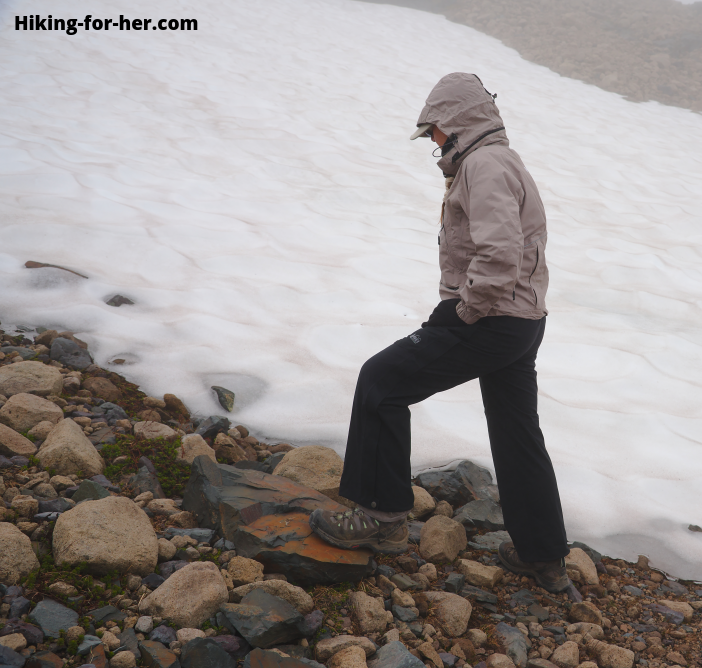
Rain jackets for women hikers
If you count yourself among those of us who hike in any weather, tackle any terrain, and smile in the face of sleet and hail, you deserve a bombproof rain jacket.
I have learned the very hardest lessons on the trail when my outer layers failed to keep me as dry as possible.
As in weeping bitter tears when my base layers and wet pants clung to me in a cold downpour.
It's moisture that you really need to pay good money to avoid.
Luckily, there are plenty of companies waiting to take your money.
In return for high quality hiking clothing that will solve your what to wear hiking problem, that is!
My approach to buying rain gear will get you started thinking about rain jackets.
Here are my two choices for quality rain jackets:
- Columbia provides good value and high quality in this jacket, which will take you through a rainy spell on a day hike.
- This is the Arc'teryx jacket I take with me into mountainous backcountry. I trust its waterproof protection and quality design.
Women's hiking pants, shorts and skirts
Now we turn our attention to the bottom half of the layering system.
You have choices to make about how much leg coverage and freedom of movement your hiking plans demand.
Here's how I've figured out what to wear hiking:
- Convertible hiking pants give you the best of the pants/shorts world. I use this style from REI.
- Leggings are versatile in cooler temperatures because they can be layered under hiking pants, or worn alone. Read my leggings review for a good option. I find that you have to be a bit more careful not to snag them, and they provide less protection.
- Hiking shorts are something I don't wear very often, but these Kuhl shorts are in my hiking clothing rotation because they're a good length (coverage but freedom).
- If you stick to maintained trails and want total freedom of movement for hips and knees, read my tips on the best hiking skirts.
More ways to pick the right hiking pants:
Rain pants for female hikers
I've already shared my philosophy toward rain clothing: invest heavily in the best fabric and design because it's what keeps you out of trouble with hypothermia.
With that in mind, I wear two different types of rain pants:
- These REI rain pants come along on my day hikes because they're not expensive enough to make me cry if they get ripped but have no trouble protecting my legs from wet vegetation along the trail.
- These are the rain pants I wear into the backcountry, built to stand up to abrasion and lengthy exposure to wind, rain and snow thanks to a three layered design.
Both pairs have stood the test of time, although the day hike rain pants do have a spot or two of duct tape on the seat. Duct tape: also durable and waterproof! Don't leave for a hike without some.
Read my tips on how to choose the best rain pants before you make a decision.
Women's hiking footwear: boots, trail shoes and socks
Notice what I did there?
Treating socks and hiking boots or trail shoes as an integrated unit makes good sense as a hiker.
You want technical hiking socks (yes, they cost more than a bargain bin pair but they also deliver more) paired with the best choice of hiking footwear for your particular feet and hiking style.
That's a lot to figure out, so dip into these detailed tips I share on what to wear hiking on your feet:
- women's hiking boots
- hiking boots for wide feet
- hiking boots for narrow feet
- waterproof trail shoes
- hiking socks
- compression hiking socks
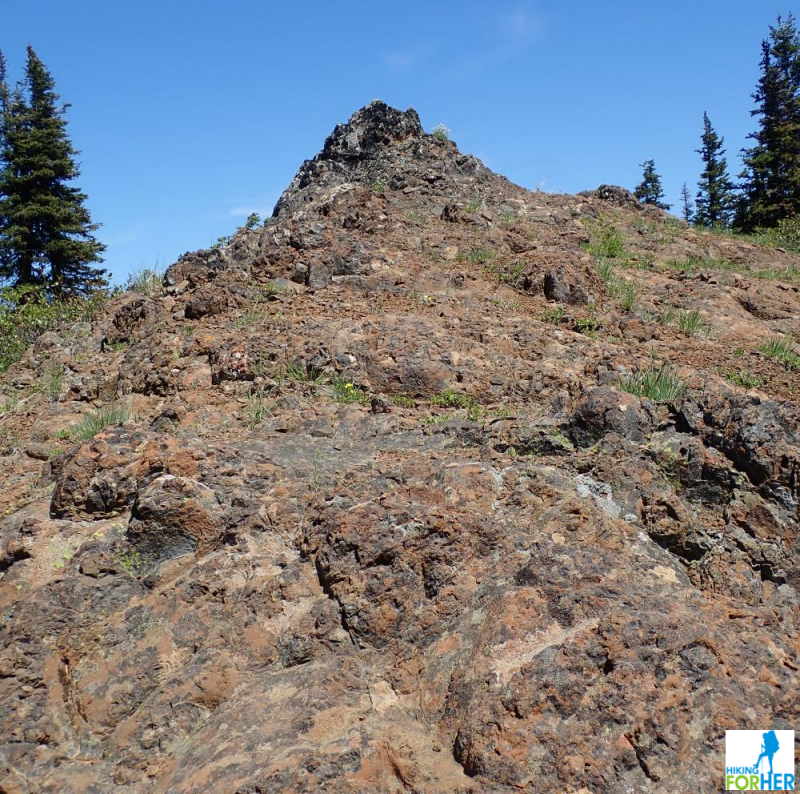 Protect your feet against tough trail conditions with the right hiking boots and socks
Protect your feet against tough trail conditions with the right hiking boots and socks
Curious about what I wear on my feet during a hike?
Here's a glimpse into my gear closet:
- For easy to navigate terrain such as a maintained trail, I wear these KEEN boots with these inner lining socks and these technical hiking socks.
- For weekly training walks on roads or local park roads, I wear these lower cut Salomon trail shoes paired with these thinner hiking socks.
- For serious backcountry hiking in alpine terrain where water crossings and bushwacking is a definite possibility, these are my trusted Salomon boots for ankle support, paired with the socks I use with my KEEN boots (above).
- I also have a pair of these Zamberlan leather boots for serious alpine hiking with these maximum cushioning technical socks.
(I have more pairs than these, but I don't want you to think I'm a hoarder!)
Hiking hats and gloves
Some might consider these fashion accessories.
I consider them essential answers to the what to wear hiking question.
Protect your head, neck and hands, and you'll be well on your way to comfort and safety on a hike.
You want to pick what will work for your hiking plans, so I'll offer what I've learned over the years to make your hiking clothing choices easy:
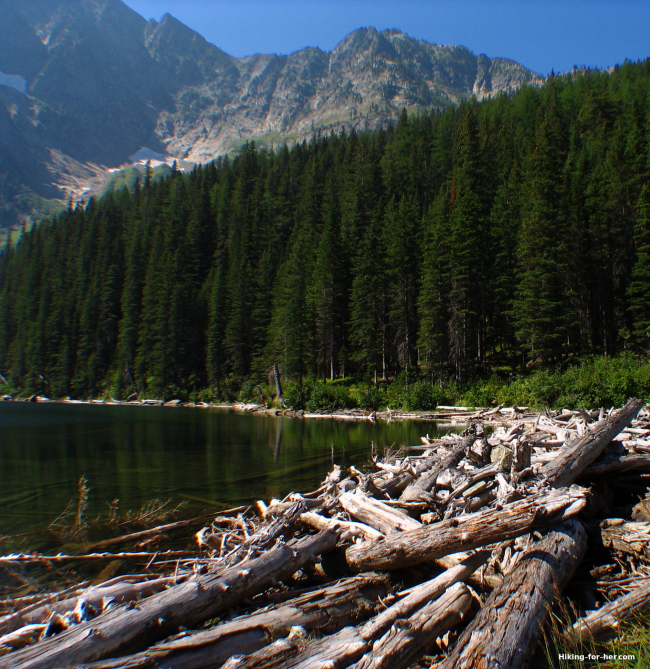 Get out there and enjoy yourself on a hike to a spectacular alpine lake wearing the best hiking clothing!
Get out there and enjoy yourself on a hike to a spectacular alpine lake wearing the best hiking clothing!And don't forget to stay warm, dry and comfortable after your hike!
Check out my review of REI Co-op's Campwell clothing line.
A few more tips on what to wear hiking
You might be overwhelmed by all the choices of hiking clothing in front of you.
But you can be strategic about adding high quality hiking clothing to your gear closet.
Here's what I do:
- I add or replace one piece of durable, wicking or water proof hiking clothing to my repertoire every season.
- If someone asks for a gift wish list, well, they asked!
Before you know it, you'll have plenty of versatile hiking clothing layers.
When you know exactly the brand and style of hiking clothing you're looking for, be sure to scour the REI outlet and Backcountry outlet every week. You might be pleasantly surprised at the price mark downs!
Now you know what to wear hiking
Regardless of your level of hiking, you have a great starting point to find good hiking clothing to add to your outdoor clothing closet.
Begin to think of the best hiking clothing as fundamental, important pieces of hiking gear.
- Every bit as important as boots, backpacks and trekking poles.
Wear the right clothes on a trail, and you'll have a fantastic time!
Or at least be well prepared for what Mother Nature tosses your way, which is a win in my book!
Thanks for letting me share what I wear hiking.
Home page > Best Hiking Gear >
What To Wear Hiking Recommendations
|
I get emails all the time about what I wear, eat, carry and love to use on the trail. That's
why I provide affiliate links to you: the best gear that I use myself and have seen used by other hikers is instantly
available for your consideration, and the gear company sends a few
pennies per dollar to this reader-supported hiking website. There is no added cost to you! Everyone ends up a winner: Great gear for you, strong gear companies, and more free hiking tips for everyone. Thanks very much for your support. It's warmly and sincerely appreciated. It also helps send these hiking tips to all your virtual trail buddies around the globe. |
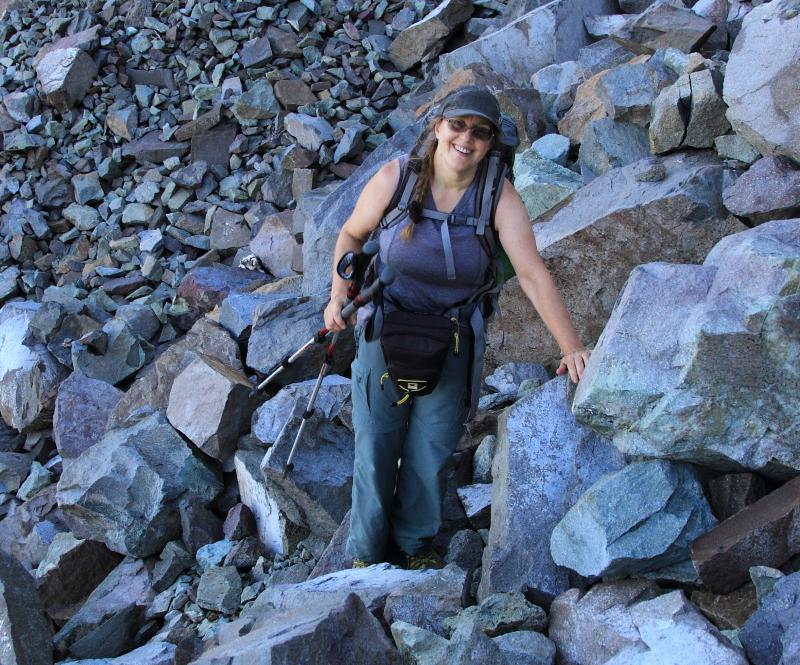 |
